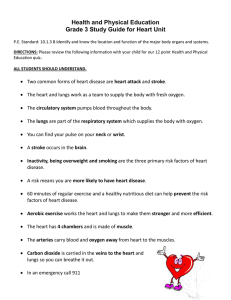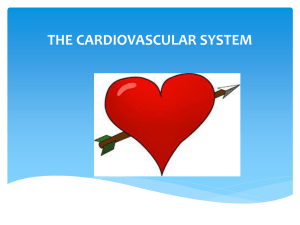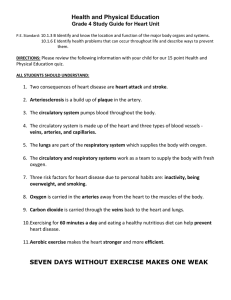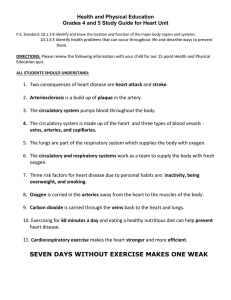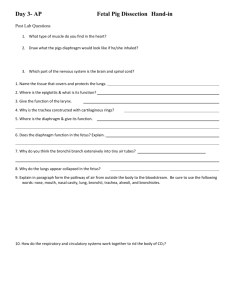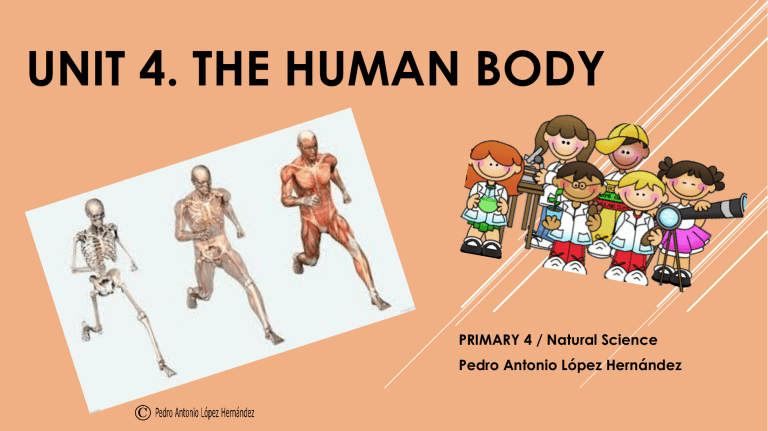
UNIT 4. THE HUMAN BODY PRIMARY 4 / Natural Science Pedro Antonio López Hernández THE CIRCULATORY SYSTEM It distributes nutrients and oxygen to different parts of the body and gets rid of unwanted substances Parts of the circulatory system Blood vessels Heart Blood They transport the blood around the body. It is a red liquid that contains the nutrients and oxygen that our body needs. There are three types: It also carries the unwanted waste substances that our bodies need to remove. Capillaries They are very thin vessels that connect the arteries with veins. Veins They carry blood from the rest of the body to the heart. Arteries They carry blood from the heart to the rest of the body. - It pumps blood around the body through the blood vessels. - It is the fist and sits between the lungs. - It continuously contract and relaxing automatically. This process is called HEARTBEAT. Parts of the circulatory system (Main map) The heartbeat Arteries 1. Heart Veins 4. Capillaries Veins 2. Blood vessels 5. Veins 6. Arteries 3. Blood The heart relaxes and fills up with blood coming from the veins The heart contracts and pushes blood through the arteries to the rest of the body. THE RESPIRATORY SYSTEM It helps us delivery oxygen to all parts of the body. It is made of: Airway Air enters and exits the body through this. It contains: - The nasal cavity. Pharynx. Larynx. Trachea. Bronchi. Bronchioles. 1. THE NASAL CAVITY heats, moistens and filters the air that comes into the body. 4. The TRACHEA or WINDPIPE is a rigid tube which carries air to the bronchi. Lungs They are two spongy organs that are protected by the RIB CAGE. 5. The BRONCHI are tubes which carry air from the trachea to the lungs. They lead to smaller airways called BRONCHIOLES that are connected to air sacs or ALVEOLI. “They are where respiration takes place” 7. The DIAPHRAGM is a muscle which helps the lungs to move in a way necessary for breathing. 2. The PHARYNX allows the air to flow from the mouth and nose to the lungs. 3. The LARYNX contains the vocal cords. 4. LUNGS are spongy organs which contain millions of tiny air sacs called ALVEOLI. THE PROCESS OF RESPIRATION Through this process, we take in oxygen from the air outside and we transport it to different parts of our body. There are three states of respiration Inhalation The diaphragm contracts, allowing the lungs to get bigger and fill up with air from the mouth and nose. Gas exchange Oxygen that we breathe passes through the alveoli and into the blood. At the same time, carbon dioxide passes from the blood into the lungs. Exhalation The diaphragm relaxes, causing the lungs to get smaller and push carbon dioxide out of the body. REPRODUCTION Human beings are able to make other human beings thanks to the reproductive system. Men an women have different reproductive systems. The female reproductive system 1. FALLOPIAN TUBES are two internal passages that connect the ovaries to the uterus. 2. The UTERUS or WOMB is the space inside a woman where a baby develops until it is born. 5. OVARIES are two internal organs that produce OVULES. The male reproductive system 1. The PENIS is an external organ that contains the URETHRA. 2. TESTICLES are two oval shaped external organs that produce millions of cells called SPERM. 4. The VAGINA is the tube that leads from the uterus to outside the body. 3. The VULVA is the external part of the female reproductive system. 3. The URETHRA carries urine from the bladder. It also carries semen, which is a mixture of fluids and sperm. PREGNANCY AND DELIVERY During PREGNANCY a baby forms and grows inside its mother. FOR HUMAN, this state of the reproduction process lasts NINE MONTHS. The BABY begins life inside the UTERUS as a tiny being called FOETUS. A baby´s development 1. He gets to know his parent´s faces. The BABY grows inside the AMNIOTIC SAC, which contains a liquid to protects it. 2. He says his first words. 3. He learns to crawl. The BABY is joined to its mother by an UMBILICAL CORD. This is how it get its food and oxygen during pregnancy. 4. He takes his first steps. 5. He says his first words. SICKNESS AND HEALTH To keep your body healthy and avoid illnesses, you must follow some routines in your daily life. Healthy habits Healthy diet - - Eat a variety of nutritious food every day. - Posture Hygiene Fruit and vegetables are especially important. Wash your hands before meals. - Brush your teeth after meals. - Have a shower regularly. Physical exercise - Do physical exercise to keep your body fit, strong and flexible. - Sit upright in your chair. - Carry your bag on your back using both shoulders. Rest - Sleep for around 9 or 10 hours a day. Unhealthy habits Unhealthy diet - Obesity - Nutritional deficiencies. - Chronic diseases. Lack of exercise Poor hygiene - - It can cause salmonella, flu, diarrhoea and sickness or the common cold. These viruses and infections are passed between people who don´t wash their hands. - It can affect the development of motor skills and coordination. Bad posture - It produces fatigue. - It can result muscular problems. Sleep deprivation - Irritability - Lack of concentration - Memory deficit


